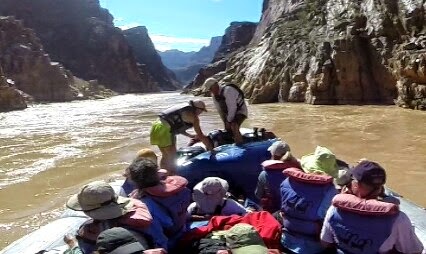Those aren’t
words you want to hear about the outboard motor on your raft, particularly in
the first hours of your first day on an eight-day trip down the Colorado River
through the Grand Canyon. Particularly, just as you are about to encounter the
first of world-class white-water rapids that the Canyon is famous for.
The Evinrude
two-stroke was nearly new, but it just didn’t want to keep running. As we
drifted uncontrollably downstream, Boatman Art yanked the starter cord over and
over but the engine wouldn’t keep running. He sprayed its cover with water to
cool it, which eventually seemed to help. After one further episode of dying,
for whatever reason, it ran just fine for the rest of the day and almost to the
end of our trip. Almost.
Without a
motor, the huge sausage-like rafts – weighing 14,000 pounds when loaded – can’t
be steered or controlled. A boatman has to be able to count on the motor for
making tricky, mid-rapid maneuvers. Some rapids, while giving
big thrills, aren’t especially difficult to maneuver. But others the guides
called “technically difficult,” meaning, for one thing, that you damn well
better be able to steer your raft when you hit them.
We quickly
learned that 39-year-old Art’s nonplussed attitude about his cranky engine was
grounded in his well-honed river skills. During the off-season, he was
warehouse manager for the raft company, Grand Canyon Expeditions. He knew
intimately every raft, every engine, every piece of equipment.
After we got
to know Art a little better, Eva confronted him with what some of us had been
thinking: “I can see it now, Art. You knew that engine was acting up, but you
couldn’t figure out what was wrong in the shop. So you say to yourself, let’s
take it on this trip and maybe I can figure it out then. So Art, was that it?”
Art just
smiled. But he didn’t deny it.
Same thing with
the raft he was driving. Said Eva one morning: “Uh, Art. We have a flat.” It
was obvious that at least one compartment in the big, silver sausage tube was
looking a little flaccid. Art admitted that he hadn’t been able to find the
leak. Although the guides would spend long minutes each day pumping up the leaky tube, by trip’s end one side was riding noticeably low in the water. Seemed to me, if air’s going out, water’s got to be going in. I’m just saying.
* * *
Our idyllic
glide down the Colorado River changed character on the final morning.
Art informed us that for the first time, we had to meet an iron-clad schedule.
To conclude our trip, we would meet a jet-boat mid-river at a designated spot
at exactly 10:30 a.m. There, we would transfer our personal gear to the
jet-boat for the last, fast leg across the flooded backwaters of Lake Mead to a
take-out point where a bus would pick us up for return to our Las Vegas hotel.
It was all very business-like and tightly choreographed.
That is,
until Art’s cranky motor quit running again. The other raft already was far
downstream from us, and we drifted aimlessly in the fast current. For long
minutes, Art and Swamper Den sweated over the engine in the baking desert heat,
fruitlessly pulling its starter cord and trying every trick to
coax it back to life. As the schedule for meeting the jet-boat slipped, we
approached a modest rapid with one big submerged rock dead-center, and we were
spinning straight for it.
Then, a clunk!
as the motor bounced over the rock and we drifted safely away.
Art’s face
relaxed. “That wasn’t so bad,” he smiled, more to himself than anyone else.
Yet, we
still were careening down the river out of control. At that point, Art gave up
and decided to switch outboard motors. The rafts carry a spare engine for just
such emergencies, and swapping them is fairly straightforward. Unclamp the old
one. Pull it up on the deck. Unbolt the spare one, drop it into place and
tighten to the raft’s frame, hook up the gas line, crank it, and away you go.
Fairly
straightforward, that is, if the big, clunky raft is tied to shore and you have
two strong people to wrestle the 185-pound outboard engines. Not so straightforward
if you’re twirling down the river with 15 passengers aboard fearing the
worst.
I think
everyone’s breath came a little shorter
as we tried to stay calm and let Art deal with his problem. Offers of help were
brushed away. Somehow, he muscled the dead engine out of the water and onto the
raft’s deck, and then with Swamper Den's help, heaved the spare into place.
One crank
of the rope and it started right up. I don’t think any of us were surprised. Art’s
one hell of a boatman, but, oh, what a price his back must have paid that day.





No comments:
Post a Comment